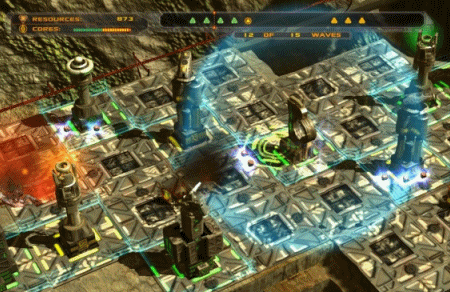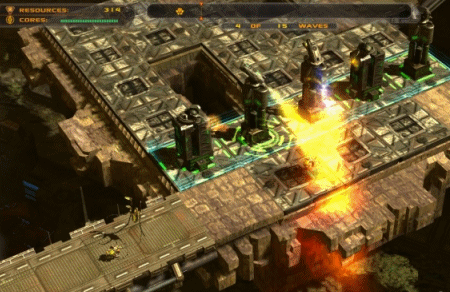 Review – Defense Grid: The Awakening
Review – Defense Grid: The Awakening

Tower Defense
A case for the Defense.
![]()
Rich
I don’t like serious racing games. Because of this, I don’t buy them. The same goes for J-RPGs, hockey games, console RTSes and, from this point on, any Guitar Hero game. Tower Defense games, on the other hand, I don’t buy because they should be free and, more importantly, I’m bored of them. It was an interesting little fad earlier on this year but now it’s over.
The reason for this outright dismissal is that Tower Defense games all play out the same way. There are three variations on the theme but ultimately it all leads to these games involving next to no strategy. You’ve got the ‘juggling’ – opening and blocking the same exits in order to move the attackers back and forth – as seen in Desktop Tower Defense, laying down your towers to make a maze or simply crowding out the entrance in order to bombard everything as quick as possible. It’s the equivalent of the all-powerful C&C tank rush and it’s gotten old.

A bit messy.
Defense Grid – DG from now on so that I don’t have to keep mispelling ‘defence’ – arrived last week on XBLA asking for 800 of your Microsoft Bumwad Dollars. A bit of a gutsy move, given that XNA already has a rather natty TD game available for 80M$P (NextWar) but bugger me viciously with an angry wasp if it isn’t actually worth it. How is this possible? Is it the polished 3D visuals? The range of attacking options? The bumbling old computer system voiceover? Nope. They’ve added strategy. Actual strategy that has you trying out all your options in an effort to complete each level as efficiently as possible.
Instead of giving you an entrance and exit and letting you defend the points inbetween, DG – more often than not – puts the entrance and exit in the same place. The intergalatic whores that enter the arena follow the shortest path possible to your defence system hub and steal power cores from it (these are your lives effectively). They then run off with them back to the exit. If you destroy them, they’ll drop the cores which will then slowly float back to the hub. If this happens to be close to the exit, the next wave of aliens may catch them – giving them an easy run out of the arena.

In the future, the penalites for speeding will be harsh.
So not only can you not afford to just protect the entrance, you also don’t get a completely free choice as to where to put your towers which means you have to make the most of your choices. Later levels mix up the formula even more, with flying aliens swooping in to cause you even more problems.
As with most games of this type, you’ve got a myriad of different towers to choose from. There are the usual standard, slowdown, scatter and missile towers as well as Tesla and anti-air options. Also, after a while an orbital laser becomes available which deals huge damage to any area of the level but it also has a significant recharge time.
|
Colin Secondary Review Not too sure where they came from (actually there was one in FF7), but Tower Defence games are apparently here to stay. Native to the internets (free no less) it seems that about every console has managed to pop out a couple – not full retail games (that would be laughable) but more as bite size XBL/PSN type games. I’m not going to lie to you, but for the most part, I am crap at TD games. I play more than the average gamer but it doesn’t seem to matter because I nearly always fail remarkably and yet I still go back to them. I can’t say this bothers me too much, Napoleon and Sun Tzu still managed to live full and productive lives. Despite my ineptitude here my opinion of Defence Grid is still pretty high. Visuals are crisp, the commentary from the AI is entertaining, and the tower types are varied enough. My favourite part of the game was completing a level and then replaying it under unique challenge conditions such as only having a set number of towers or money (it allowed me to get more use out of the easier levels) . Give the trial a whirl and see if you can perfect a few of the levels, if so – do me a favour and tell me what I’m doing wrong. Next up… South Park Let’s Go Tower Defense Play! Secondary Score: 7/10 |
If you’re keeping one eye on the achievements, you’ll be looking to get gold medals on each level. This involves not losing any power cores whilst also saving as much money as possible. Lovely gamerscore aside, this is the way to get the most out of the game as it turns each level into a puzzle with the logic decisions involved resembling a kind of combative sudoku.
Whilst the gameplay ticks all the boxes, and then some, for this type of game, DG seems to be receiving the most plaudits for its presentation. This is mostly down to the ancient technology look of the game. Each level is set in a long-forgotten defence system – often described by the aged voice of the system itself – and whilst it all looks very nice with its slight steampunk echoes, I’d have preferred a clearer view of proceedings. Also, while the left stick can zoom the camera in and out, a fully rotatable view (with more zoom options) would have made things a lot easier. It’s a shame that the aliens don’t stand out particularly well against the background either or that their energy levels aren’t visible by default (you have to press B to see how much life they have left).
Still, none of that has too much of a negative effect on the gameplay and the stirring music, combined with the not-too-irritating voiceovers, does help to create more atmosphere than the average TD game. So, if you fancy checking out the genre – or at least giving it one last go – this is as good an example as you’ll find anywhere. It may well be more suited to the PC but the console controls don’t get in the way at all. Defense Grid is definitely worth the 800M$P, it has over twenty substantial levels and various game modes that add different levels of challenge and while casual players will be happy to just beat the levels, veteran TD players will enjoy going for the gold medals.
I expected Defense Grid to be, well… gash, but actually it’s a bit of a gem.
Rating: 








 8/10
8/10
